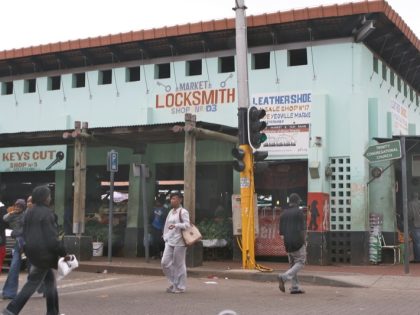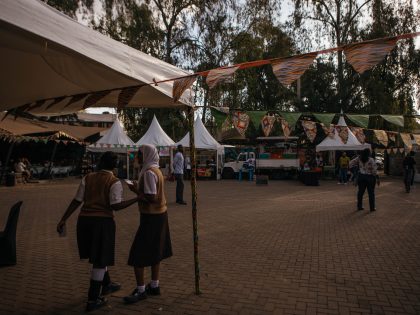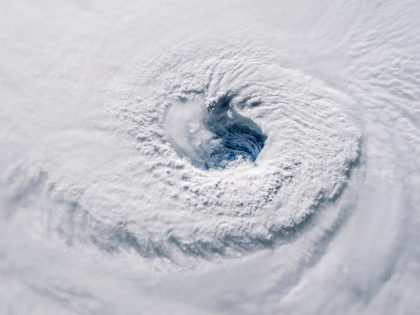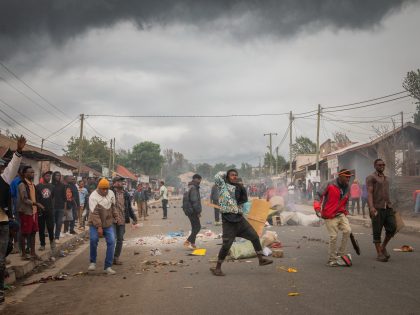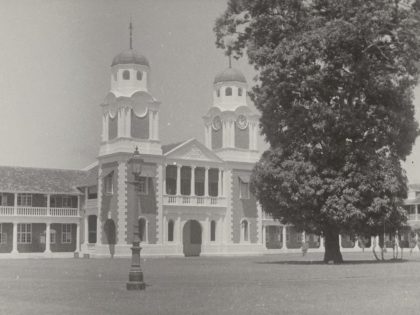Redefining “Blackness”
An interview with Nigerian-American artist, Toyin Odutola.

All images courtesy of Toyin Odutola.
The richly layered portraits of Nigerian-American artist Toyin Odutola have been on the Africa is a Country radar for quite some time. Painstakingly created with marker and ballpoint pen, Toyin’s drawings have been making waves in the art world and across social media platforms. Aesthetically striking in their own right, Toyin’s unique style sparks important questions about the concept of identity. Her pieces tempt us to wonder about the identities that society projects onto us and more reflectively, how we have been sculpted by time into who we are at any given moment.
2012 has been an important year for Toyin’s progression as an artist. She received her MFA from California College of the Arts, published her first book of drawings—Alphabet, completed two residencies, including one at the legendary Tamarind Institute and exhibited works in numerous group shows including the “Fore” exhibition which is currently running at the Studio Museum in Harlem until March 10, 2013. With a major solo exhibition lined up at the Jack Shainman Gallery in April, the year 2013 is poised to be quite notable for Toyin as well.
We spoke with Toyin about her thoughts on post-racial aesthetics, perceptions of “African” art, androgynous figures and the nostalgic crystallization of past selves through portraiture.
Toyin was born in Ife, Nigeria and raised largely in Alabama in the United States. Her self-published book Alphabet is available here. Find Toyin on Tumblr, Instagram and Twitter. As a tribute to the manner in which Toyin methodically documents her artwork on her blog, the images above illustrate the progression of how her portraits come to life. Some excerpts from the video interview can be found on YouTube.
Your predominant style of drawing involves creating a figure with many layers of ink, do the layers contribute to the mapping of the skin’s geography?
Absolutely, in the sense that the process of making layering, is, in essence, geography. I think a lot of people look at my style and they think it’s a means to an end, but honestly it’s the only factor. I think about what other people read in the work and it’s interesting, they find other things that they like, but for me it’s always been the skin. The skin is the most interesting thing. And it’s the reason I go into it as hard as I do. Many people will say “I really like the eyes,” or “I really like how you draw the hair,” but to me that’s embellishment for the skin. It all boils down to the skin. The whole geography of skin thing has kind of shifted I guess, with color — the sort of color pieces that I’m working on — because I think people are seeing that the language is expanding. So for them it’s like, well, are you trying to create a whole new geography, an imagined geography, as opposed to something that’s a little bit more personal to the subject or grounded to reality in any way. I never really was grounded to reality, at all. My work doesn’t look like anything in the real world. So for me it’s always been an abstraction — but it’s an abstraction that is the lie that creates the reality. In the abstraction something real comes forth.
From some of your earlier interviews and then through your book, the way you actually talk about the skin and blackness has evolved and shifted.
I definitely sense that, but I’m also a bit nervous about it, because when I started this whole thing — around 2009 — it was just a means of making me not go crazy, honestly. It was so immersive and I could just lose myself in the meditative form of repetitive archs and puzzle-like form that I would never pay attention to the fact I was homeless and I had no job and I was really depressed. From that really dark place, I gained sort of a thing. For me every time I see the transition I remember that dark place because it was the reason I started.
Discovering and finding comfort in your own identity is a major theme of your book Alphabet, how has your art evolved as your conception of your identity has evolved?
Alphabet was my thesis. The way you present a thesis in my school (CCA) is that you have to talk about everything that your work is about. The program was really immersive and so they wanted you to provide a thorough context for your work. Alphabet became an Oprah Winfrey session, where I just poured out everything and Alphabet, the book, was a much-abridged version of that. It was both cathartic and nice to get it published, like a form, and say: this is my life. On the one hand, I’m this black woman artist, but on the other hand I come from a very specific identity and a very specific string of events. Some of it is recognizable to people and some of it is not. Alphabet was a shift happening in me and I wanted to record it, and I did, and my work has changed with it.
 Often in popular discourse, the term “African” is not simply a geographical descriptor, it comes with cultural projections, As a Nigerian-American artist, to what extent is your artwork labeled “African” and how appropriate do you find that branding?
Often in popular discourse, the term “African” is not simply a geographical descriptor, it comes with cultural projections, As a Nigerian-American artist, to what extent is your artwork labeled “African” and how appropriate do you find that branding?
I’m proud that it’s called “African”. And I’ll say that without having an illusion of what Africa is tied onto. Because my work and many works like it are whistleblowers to the illusion of Africa. I think there’s this idea that African artists have this soulfulness that is inherent in the continent and create these grand narratives. But what I’m doing is, literally, drawing people. In a very basic way. With a pen. And that sort of resourcefulness is very African I think. Because you take something that seems very rudimentary, and you really go ham on. That might be something that is distinctly African. On the other hand, I’m specific to being Nigerian, so when I hear “African” it just seems like they’re lumping me into something immediately and not taking the time to research me. It’s annoying because whenever people talk about art history they just talk about Europe; so when you hear artists say “I’m a European artist” people are like “Okay, but say you’re Italian.” They take the time to be specific with Europeans so why can’t they take the time to be specific with me? It just seems kind of lazy.
Sometimes it is a good tag. Sometimes it is not. It’s a love-hate thing. So, again, whenever I hear “African” I don’t really know how to respond to it. I feel very proud to be a part of something that up to this point has been used very negatively; something that has been excluded or omitted in the art world. So it’s really nice to be someone who comes from that continent and says, “Hey I have a voice and you better listen because I have a right to it.” On the other hand it’s getting old because it’s 2012 and people still don’t know where Nigeria is located. It’s always going to be a struggle, probably for the rest of our lives, sadly. Maybe when I’m 40 people will be like, “I totally know where Nigeria is, I totally know about this culture.” The way that they know about France.
As a follow up to that, what do you think when some exhibitions are curated as a collection of “African” artists and they box you in to being an “African” artist as opposed to being a simply an artist?
I just returned from a show of African-American artists [“Fore”] and that was really interesting. I think that was the first time in New York where I was with some high class African-American people. A majority. It’s fascinating to me because we need those things. That’s the sad thing. It’s because of our society that we need those exhibitions, even though they’re something of a double-edged sword in their own way: they’re limiting us to a very specific way of seeing the world — but what they’re aiming to do is bring that specificity for people to come in and they see our universe. But how many people are going to go in without some kind of preconceived notion?
I think whenever anyone lumps me into an African genre, again I’m proud to be in that show, I’m happy that that show even exists, but I don’t want it just to be black people coming to the show, or only Africans. Yes my work deals with that subject matter, but that doesn’t mean you can’t come and see it if you are Asian, Latino or Caucasian. It doesn’t matter to me. It’s the fact that you’re even allowing the time to investigate my work. That is why that African show is needed — often times a lot of black artists aren’t included in shows, unless you’re a super mega artist. If you’re an emerging artist, you need that kind of exposure early on in your career. Not everyone is Kara Walker or Glenn Ligon, for whom it of course also took a while to be who they are. I mean Julie Mehretu took a minute to be Julie Mehretu and she wasn’t even dealing with representational work. It is what it is.

Your works often explore elements of “blackness”, though your portraits depict people with a variety of cultural backgrounds; do you consider the redefinition of “blackness” in your work to be post-racial?
Oooh. That’s such a dirty and weird word, “post-racial”. Thelma Golden is the one who started the idea of post-racial in the 90’s. I don’t think we’re post-racial, ever, until people stop thinking about race. Which is not possible. One of the things that I like about Hank Willis Thomas — the air I breathe — is that he is such a genius in undermining the ridiculousness of race. I posted a video where he boils it down, he says, “[race] has been the most successful marketing ploy in the history of the world.” I just love that. And it’s totally true. Because everything that we think about another race is false. It’s completely false. The whole thing about blackness for me is that I wanted to make the work as dark as possible when I started because I’m a dark person and I wanted to capture what it feels like to be black. And then it just evolved. I started thinking, what if I draw this Asian guy as dark as possible…what does he become? Does he become black because I draw it or because they think he’s black? I even did his hair the way he has it. And still people will be like, “Oh. What is she trying to say?” And I’m like, “No, it’s an Asian guy that I just drew this way.” Suddenly it’s about my experience and my blackness and it’s not about him at all anymore and that’s a really fascinating process for me to digest. I’m the devil’s advocate when it comes to blackness. It’s always going to fascinate me because I’ve been treated a certain way since I was a child because of my blackness, which has been imposed on me. So for me to explore that in my work is to question why I was treated this way and how people read other people.
To me the interesting thing about blackness now is the pen. When you see a black pen, it’s not black at all. I love the moment when people see my work in person and they’re like, “Oh, but it’s not really black?” Taadaa! That’s why I use pen. Because it’s not black. The ink is not black.
These days, if you draw a black figure, because you’re coming from a place where you’ve tried to understand blackness as a concept, are you drawing that figure with a narrative of blackness or is it simply to say this is a person and we don’t have to deconstruct a racial message?
Blackness was a concept in my earlier work. It didn’t have to do with the person, it had to do with the concept of blackness, literally, because I wouldn’t even give them names. I would call them “female this” or “boy that”. I didn’t really think about people until 2011. It was just: here’s a person who is black. And black in itself is twisted, because that is a material description. So before, I was definitely aware of the history of blackness in aesthetics, especially representational aesthetics. When you’re doing portraiture and you’re a black person and you’re portraying black figures, there’s always going to be a loaded history. I had to go through that to get where I am now, which is a very freeing place, where the black figures that I make can be various. The work isn’t limited to that history anymore. And I think it has to do with the time that we’re in. People are more free to be themselves and they’re black, whereas before you had to represent blackness so much and you had to sacrifice a little bit of yourself to do that. Now it’s more like I want to be me and me can be all of these things at once and have nothing to do with black social representation at all.
I actually am a super formalist — a dirty word in art school. No one wants you to be a formalist, you have to have a message. I look at Lucian Freud because he really was the embodiment of his craft being the message. The time it took, the labor, the way of looking at a person, that was the message. Because he drew predominantly white people so no one really assumed anything else. Take Elizabeth Peyton for example. The thing that really infuriates me is that I can’t be an Elizabeth Peyton: painting and drawing people in my life, who aren’t famous and who have no significance besides my connection to them, but I draw them in this way where I’m full-on adorning these people and all the public has to do is digest them as pretty. Peyton’s gotten a little more political recently doing portraits of Kanye West, but of course black people, they’re always political. That’s when her message shifted. I think for me the moment I came out to do the work it was considered political, because it’s the idea of seeing black men, black women, androgynous figures overall, being presented in this way was very different so of course I’m going to have to push a message with everything. But in the end I just want everybody to think “That’s a really pretty blue.” “I like that lash right there.” Because that’s what I see. I see the lashes, I see the fine points, but no one wants to focus on that because it trivializes a bigger issue and I understand that. The bigger issue is that we still have issues of representation in this country and that’s a fucking big problem. Sometimes it’s very frustrating to be an artist in that arena and you’re like, “I don’t want to always have to represent everyone.” But at the same time I have to, because no one else will. It’s the great burden of post-racial artists.

Do you think in your lifetime you’ll be able to get to a place where you’ll be able to transcend race with your art?
If you look at black history, especially women artists, usually the moment when they get famous for being what I’m seeking out is the moment they die. Think Zora Neale Hurston or Josephine Baker, women who were very specific about not looking just at race, just at social representation, but rather at the artform itself. Time had to shift. But then I think about people like Toni Morrison who in every essence created works where the foundation has been about blackness and black representation, but she’s transcended it completely. And she’s still alive and she’s still kicking it, but when people think about Toni Morrison, what’s the first think they think about? “Mmm hmmm Negro Spiritual” [singing]. And she’s more than that. So maybe when she passes away – and I don’t wish that upon her – but chances are, that’s when it’s gonna shift. Same with brilliant luminaries like bell hooks and Octavia Butler. I don’t know, maybe in my lifetime…I’m not holding my breath though.
Many of your drawings are self-portraits, what drives you to capture many different variations of your own image?
There’s a Romare Bearden quote that I posted on my website where he talks about how it’s always difficult to draw yourself because you’re always at issue, you’re always changing, especially if you’re an artist because you see everything. Observing yourself is very uncomfortable and you’re more attuned to a shift. It’s very difficult to draw yourself and think that’s it. A mirror isn’t the only form that can capture you, you can do it in so many different ways. Noah Kalina, the guy who takes his photograph everyday, is a brilliant example of that. The idea that you’re always at issue, you’re always changing even when you look exactly the same, with the exact same face, everything is shifting. I draw myself because I want to capture a shift. That’s why I always get tattoos, they’re temporal, they represent a time that’s passed. It’s a moment to take a break and look at myself properly. It’s not just how I look, it’s what has happened. As James Baldwin says, “Where I’ve been and what I’ve been.”
The reason I started doing self portraits in the first place was to see myself. Not just in a mirror or in a photo, To really take the time and look. Through that I’m getting at the psychology of looking, I’m really getting at what I was thinking, what I was feeling. There are moments when I think, “Oh my god I hate my face,” but I also have moments where I think — and it sounds totally narcissistic and it’s not meant to be — “I have a really interesting face.” It’s the same reason why I’ll draw my brothers ‘til the day I die, because they have the most interesting faces. Especially my youngest brother. He’s 6’7” and he’s got these huge eyes and he’s always looking at me with this look of incredulity. He’s like “Really?” I love that. He has so many variations of that “really?” He can do “really?” from the back. He can do “really?” from the side. He can do “really?” looking up.
You were born in Ife, Nigeria, but you have lived much of your life in California and Alabama, all very different cultural environments. How has this plural cultural experience shaped your artwork?
It’s helped in color. It’s helped in tone. It’s helped in creating puzzle-like forms. I always go back to memory when I work. For me it’s constant. They’re not even places I have lived in the past tense, they’re always relived in a way. I’m still there and they’re still shaping me.
Your drawings portray people not only as they are, but often as they were at some previous time; is there a certain nostalgia captured in your pieces for the selves of moments passed?
It’s all nostalgia. It’s all about time. The reason why I’m always obsessed with capturing myself is because I know I’m never going to be that way ever again. There’s this piece I did called All these garlands prove nothing (2012), which I made when I had super long hair. That piece got damaged in Hurricane Sandy and I was really bummed about it. It wasn’t the only one that got damaged, but it was the one that was hit the most. There’s a lot of emotion involved with the series I’m working on now. It’s the idea of literally something lost and what you do in response to that. So I started drawing all the hairstyles I’ve ever had. Which are a lot actually. I had this punk thing, I had an afro, I had long hair. You’d think I was schizophrenic, but it really was just me trying to discover myself and figure out what I can get away with. While I’m working on this piece, even though I’m spending a lot of time on the details, I’m aware that people are not going to see that or it has the potential to be gone. All that time I spent doesn’t matter anymore. The piece doesn’t exist in that same way again. That was a big wake up call recently. The amount of time I spend on my work and what it really means. Does the time spent equal the time that’s lost?
 Some of the figures in your drawings appear androgynous, is there a message about gender that you are trying to convey through such pieces?
Some of the figures in your drawings appear androgynous, is there a message about gender that you are trying to convey through such pieces?
I am a huge fan of androgyny. I think more people should be androgynous in portrayals. I embrace the masculine and feminine side of myself and I like to explore that in my drawings. When I draw my brothers in particular, I exploit the feminine. I always give them huge lashes and I always capture them in poses that are not quintessential black male poses. There’s one piece that’s based on a photo I took at the Abuja airport, which is absolute chaos, where my brother’s head is cocked up and there’s a tinge of terror in his eyes. He was trying so hard to be this calm, cool black dude. I loved that. I called the piece Uncertain yet Reserved (2012) because he was reserving everything. He was trying so hard to hold onto his blackness, his maleness, but he was very scared and neither of us knew what was going on. It’s the slight sense of uncertainty where his eyes are wavering. I love that kind of portrayal. The whole point of exploiting that gender construct is to get at the person and not get at the label that society wants to put on them. It’s all about the social construct of an identity and the reality of a person, which are very different things.
I’ve always been some who’s been very androgynous. I’m glad I’m a woman. I love being a woman, but I’m also aware that I have very masculine sides to me. That’s something for black women that you don’t see a lot.
You are a prolific blogger and instagram user, documenting your artistic process and your musings, does interacting with your audience impact your pieces?
I remember when [blogging] was a really weird thing I did on my own and I had ten friends. It was really personal. It was me. I would go back and I would say, “What did I do with that piece again?” and I would literally go back into my archive and I would look it up and watch the different stages because I was so obsessive about documenting everything. I would watch how I had constructed it. No one else gets it but I do so I would look at those pictures and think, “I got it. I know how I did that piece, now I’m going to apply it to this one.” But then suddenly the audience also got involved. There would be questions and it turned into a dialogue. Back then it was a beautiful moment where there were these very cerebral questions that really made me take a step back. I often came up with rather long answers, but it was because I was thinking. What those questions did for me was provide questions for my thesis. Which is what Alphabet is about. That’s why I wanted to publish it — because it started on the blog. If I hadn’t had those questions I don’t think I would be eloquent enough to talk about my work. Dominick Brady would ask questions, and so would Derica Shields — people like that who were thinking as they were seeing my work. I received really hard-hitting questions where it took me three days to respond to. Now I get the questions where someone asks, “How do you figure out your color palette?” I want to say, “Figure it out yourself!” I’m not going to answer everything. There’s a lot of really young people that follow my blog now and I totally get that because when I was 17 I was also wondering, “What oil medium does Lucian Freud use? Does he use linseed oil? Oh my god.” Can you imagine if Lucian Freud had a blog? I would kill him with questions. Every time I get annoyed with questions I imagine Picasso having a Tumblr, I’m sure people would ask him the same thing. Or Matisse.
On your blog Obia the Third, you often share quotes that resonate with you from the likes of Zadie Smith and Virginia Woolf. How does literature inform your artwork?
Well, it’s really great for titles. I’ve always loved reading ever since I was a kid. I remember the first time I read a Zadie Smith book, who I adore. I think she’s the female literary equivalent of me as an artist because she’s always questioning herself and that’s something I do when I work. I love to read interviews with her equally as much as I love to read her books because they are such brilliant windows into her world. Same with James Baldwin. Interviews with James Baldwin are the Holy Grail. He’s so on it, he’s so aware. I’ve read Another Country 50 billion times.
We live in a world where we’re so inundated with visual language that people think they know what they’re seeing when they don’t. So you need literature to hone it into something very specific. I’ve noticed many times when I leave my pieces untitled, peoples’ imaginations will run crazy. So it’s about taking control of what I’m making and getting to a point where I’d like the audience to start from instead of just having them start from wherever they feel like. If you look at any major artist, they have to write something. We can’t just leave it at the art alone anymore. You have to write so you have to know what good literature is. My style is very much a reflection of people I read. Literature allows me to properly talk about my work. If I were ever to meet any of these people I think I would probably cry. I’m terrified too, because I would probably get a restraining order on myself.
But here’s a question, how accessible should writers and artists be? I always question that, especially with my blog. How much is too much? I’m getting to that point where I’m thinking I need to take a break because people start thinking you owe them something. No artist owes you anything. So how accessible do I want to be and how much mystery do I want to keep? I used think mystery was bad for a very long time. I thought I had to be as transparent as possible. And now I’m like, “No, I need to protect myself.” I’ve had a couple shows were people come up and they touch me. And I understand that because I was always someone who was a fan. But now someone is a fan of me, which I find incredibly crazy because I’m a crazy person. Online life and real life interaction is very different for me. If someone is going to message me online, there can be this tone of authority. That’s where I feel the access stops. But if you come up to me in person and you say you just want to talk to me for like 5 minutes, I’ll talk to you. Online it feeds into the fantasy of what I am, but if you talk to me in person you get to see that I’m just me and that I’m awkward and silly.

You’ve mentioned Hank Willis Thomas, Kara Walker, Kerry James Marshall, Lucian Freud and Korehiko Hino among the artists you admire. Who would you most like to collaborate with?
Hank is N°1 because he’s such a good collaborator. He’s the collaborator king. Kerry James Marshall too, but I’d be so terrified I probably would end up doing nothing, I’d just watch him the whole time. For a lot of these people I would just want to be in the same studio working with them, but not necessarily literally collaborating. I would love to meet Takehiko Inoue, the guy who did that Vagabond series that I love so much. I just want to be in his studio drawing with him. His energy to me is so inspiring. If you see him work he’s like a machine. He’s making these huge pieces. He’s the only reason that I think I have a possibility of doing large work because he’s doing ridiculous detail.
Hank Willis Thomas has been a part of your career from early on and has facilitated your development as an artist, he clearly digs your work, so what is preventing the Hank-Toyin collaboration from actually happening?
I feel like he’s just so busy, but it’s probably gonna happen. Knowing Hank, something’s gonna come up. The reason I studied at CCA was because of him. He graduated from that school and I thought if this guy went there and was able to make that kind of work, I am in. He’s the reason I’m even having this interview. I joke around a lot, but I owe him so much. He’s been so supportive. He’s the kind of person that you would want as a mentor because he’s honest, he just tells it as it is. In the art world, no one can prepare you for this craziness. It’s so nice to have someone to help you navigate because it is treacherous.
So someday. I hope so. Put it on blast. Say, Hank, I’m ready to collaborate.
You have a solo exhibition scheduled for April 2013 at the Jack Shainman Gallery in New York City, is there a theme that unifies the pieces you will show at that installation?
I’m trying. I’m all over the place because my interests have been all over the place. Ok, I’ll give you an Africa is a Country exclusive. Amber. That’s all I’m going to say. Every bit of the definition of amber is what I’m really interested in right now. And it’s been making sense for the color choices I’ve been making recently in the last few months. But it’s really hard for me to bring pieces together for a show. Even for [my previous show] MAPS it was like two separate shows. There was a lot of older work and then there was a lot of this new sequential work. At the end of the day it’s probably going to be that way. Two ways of seeing will definitely play into it. I have the whole gallery this time, which terrifies me. I’m excited, but I’m also dreading it a little bit because I really don’t know what people are thinking. At all.
There are a lot of people saying I should do a life-sized portrait. I’ve done full body before. For me whenever I introduce naked bodies it’s a whole other conversation. Do I want to have that conversation? I’ve had people be annoyed that I don’t do full bodies and I just say, “Trust me. There’s a reason I don’t do naked bodies.” I did it before and people think, “Oh my god those are her boobs!” First thing. And then of course it becomes this thing about slavery. People say I’m commentating on that, which I never am. I might do one and make it really uncomfortable for people. Something really inappropriate. And maybe then they will get off my back. But they’ll probably want more. They’ll say, “Why don’t you do 5 more of those pieces?” The full body thing is interesting in the sense of doing something like Laylah Ali’s Greenheads; something that deals with a narrative. If I present a naked body, it’s going to be a group of them doing something. And I don’t want it to be referring to some classical arrangement, I want it to be its own story, in its own world. And that takes time and planning and you really have to know what you want to do ahead of time, which I never do. So it’s not something that’s out of my purview.
In the letter A in Alphabet you describe the people you’ve been during your lifetime; who are you at this very moment?
Still trying to figure that out. I’d say I’m very indecisive. Unsatisfied. A completely self-indulgent draftswoman who came back to the South because she needs to find grounding at a crazy crazy time. Someone who’s questioning her very image and the mythology around people more than ever.













